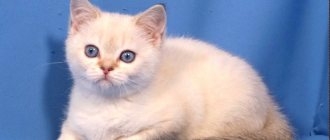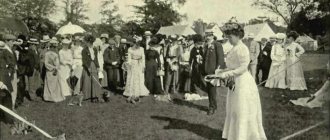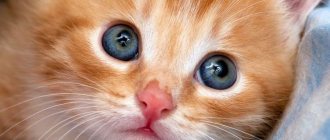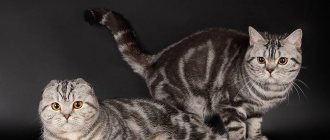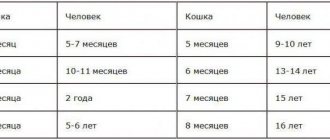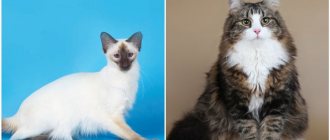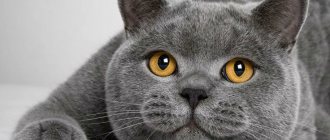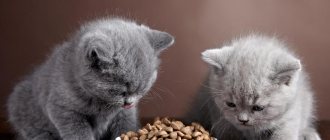History of cats and their breeds
Cats and cats are creatures of nature, and their preferences are natural. To procreate, they choose a couple based on certain criteria, where strength, endurance and health come first, and only then external data. The domestication of cats began about ten thousand years ago, and at that time all cats did not have a specific breed, but living in different areas, they differed in appearance and character.
As cats from different areas spread throughout the world, they crossed with each other and the first mestizos appeared, which, in turn, continued to reproduce. This is how modern cats appeared, which differed in physique, length and color of fur, and character. With the development of progress, the study of genetics began and the identification of the causes of differences in the color and character of pets began, as well as their unification into separate groups - breeds.
All breeds have their stories:
- Some arose naturally without human intervention, such as the Siamese cat.
- Others are bred artificially, through long-term crossings of different species. One of the representatives is British. In fact, this is a mixed-breed cat whose parents were English and Persian domestic cats.
- For still others, the main distinguishing feature of the breed is caused by a gene mutation, for example, in Scottish cats it is folded ears. Subsequent work was aimed at preserving such features.
Today there are more than 400 cat breeds.
Description of breeds and differences
British and Scottish cats are very similar. However, among the British there are no cats with floppy ears. The main common features of both breeds:
- rounded head;
- round, wide eyes;
- muscular body;
- smooth transition from forehead to muzzle;
- pronounced cheeks.
The differences between the cats are as follows:
- The Scots are more graceful.
- Scottish cats have ears that are erect or drooping.
- The Scottish tail is thinner and more flexible than the British tail.
- Britons love solitude, while Scots need communication and attention.
Return to contents
Interbreeding options
Scottish and British cats were often crossed with representatives of other breeds. The kittens of some of them have received recognition from world associations of cat lovers. Others simply remained mestizos, who do not participate in breeding or exhibitions. Experimental crossbreeding of Britons and Scottish Sheeps was carried out with the following breeds:
- Siamese cat. As a result of mating Siamese with Scots, the Siafold cat breed was developed - a Siamese with hanging ears. And in 1962, it was not without the participation of a white British woman in breeding Foreign Whites - a Siamese cat of an absolutely white color.
- A cross between a British and a Persian. These cats are distinguished by their large size, rather straight nose, and long hair. Crossing a Persian Fold with a Scottish Fold is not advisable because the kittens' ears stick out to the sides rather than curling up and their fur is longer than expected.
- A cross between a British cat and a regular cat. Such a kitten has a powerful physique, but does not meet the standards of the British breed in terms of the appearance of its face, paws, tail, and colors. Such animals have no breeding value.
- A combination of British and Siberian cats. The babies contain the features of both parents, although they do not look the same in the litter. They are distinguished by an elongated muzzle, long or short hair, a mixture of colors, and large sizes. These animals can have many health problems.
Return to contents
Mixed cats
Despite the fact that kittens from representatives of various breeds can be bright, graceful and funny, mixed breeds will never become the owners of a pedigree and will not take first places at exhibitions.
Mixed-breed cat - what is it? The answer to this question is known to every breeder, who mercilessly cull kittens born from different breeds. But many modern breeds appeared through random crossing. This is how the Broomilla breed arose from a Persian father and a Bruma mother. The first offspring was not considered a breed, but thanks to the work of the breeder, who continued to work on improving the new species, the Broomilla was recognized and included in the International Register of Pedigree Cats.
Is it possible to crossbreed a Briton and a Scot?
All cat breeds have a common genetic sex pattern and the same number of chromosomes, so they can be bred with each other. In the process of breeding history, the Scottish Fold (low-eared) breed was formed.
Mating between this breed is strictly prohibited. Both partners have a gene for lop ears, which leads to genetic mutations. It was possible to get rid of the defect by crossing Scottish Fold cats with straight-eared British cats.
To maintain the standard of the Scottish breed, it was allowed to breed Britons with Scots, although matings between them were prohibited in the British breed.
The litter belonged to the Scots, they were recorded as:
- Scottish Fold - fold-eared kittens;
- Scottish Straight - individuals with straight ears.
Gradually, the appearance of the Scots began to differ significantly from the British. The ears, body size, length of paws and tail have changed. Unlike British cats, Scottish cats are lighter in bone, smaller in size, have a rounded head with huge eyes, small ears, and long hair. They are harsher in character.
Straight ears are the only difference between the Scottish Straight and the Scottish Fold. The World Cat Federation has registered the Scottish Straight as "Scottish Shorthair". The breed received the right to participate in the championship. To preserve the breed characteristics of the Scots, Folds stopped crossing with the British and started with Scottish Straights.
Kittens born from two British parents are considered British. If other representatives of the breeds participated in the crossing, the breed characteristics deteriorated. As a rule, the color of the British is blue. When crossed with exotics and Persians, the shade of the coat changed to other colors - smoky, black.
Be sure to read:
What food to feed Scottish Fold adult cats and kittens correctly
Métis British
Mixed breed cats have always existed, and the British are no exception. The history of their origin began with the islands of Britain, where imported Persians were crossed with local representatives - English domestic cats. The new breed was called British. She combined English intelligence and Persian proud stubbornness.
To obtain new colors, breeders crossed this breed with their relatives, the Persians. As a result of their labors, a mixed breed of British and Persian was born. The breeding of such mestizos continued until 2003, after which it was prohibited due to signs of degeneracy in both breeds. Today, a kitten from a Persian cat and a British cat is characterized as outbred and does not receive places at exhibitions.
Also relevant were the matings of British and Scottish shorthair cats, which were used to breed Scottish Folds or Scottish Folds. Since lop ears are caused by a mutating gene, mating of two mutants is prohibited due to the risk of hereditary diseases and skeletal deformities incompatible with life in the offspring.
Appearance of mestizo
With the Scots, it is impossible to know in advance who will be in the litter - straights or folds. 20 days after birth, the ears begin to fold and the breed can be determined.
Although in such cases people make mistakes and incorrectly determine the type of animal, since folds’ ears also sometimes rise.
However, if a mating of British and Scottish cats does occur, then the mestizo will have the following characteristics:
- stocky body;
- the head is large and round in shape without a visible transition to the body;
- the nose is straight and slightly concave;
- chin well developed;
- the ears are erect; if the gene for lop ears has been passed on, then a slight fold forward is observed;
- round eyes, eye color can be any;
- paws are powerful, rounded at the ends;
- the tail is elongated and thick;
- the coat is thick and short, there is an undercoat;
- The color is plain, sometimes with a tabby pattern.
The genotype is more similar to the British Fold, which is why people purchase kittens as “British Fold”. However, this species does not officially exist.
It is forbidden to consider them British with such a mating. A kitten born from a British and a Scotsman is classified as a Scottish breed.
The result of mating a Maine Coon and a regular cat
The cat and the Maine Coon cat were bred naturally and all efforts of the breeders are aimed at preserving their character traits:
- friendliness;
- poise;
- agreeableness;
- caution;
- lack of aggression;
- loyalty.
A Maine Coon mixed breed, obtained as a result of mating a representative of the breed with an ordinary cat, loses its characteristic features or they are distorted. The color of the coat will not change much, because most outbred cats have a color similar to the Maine Coon, but genetic traits of their ancestors may appear. Eye color will depend on the dominant color of the father or mother.
Maine Coons have medium-length hair, and if the partner was smooth-haired, then the kittens will be born with short hair.
Character, weight and body structure are difficult to calculate. A Maine Coon mixed breed can combine the traits of both parents and have different characteristics. Kittens are more massive than outbred cats, but inferior in size to purebred cats, the same applies to their character: some are affectionate, others are more aggressive.
Care and maintenance
To properly care for a mestizo, you need to know from which parents he was born. If several varieties of purebred genes are mixed in the kitten’s blood, then the best adviser on keeping the animal will be the breeder, who will tell you what nuances you need to pay attention to.
If the animals do not require special care, then standard procedures are carried out:
- inspect for fleas;
- get rid of all parasites;
- get vaccinated;
- carry out sterilization.
Cats have their teeth and ears cleaned and their fur combed once every 10-14 days. Bath felines if necessary.
Additional information: Cats can suffer from a variety of infectious diseases. The most dangerous are: rabies, feline distemper, calcivirus, coronaviruses.
The appearance of vomiting, diarrhea, and ulcers on the body should be an immediate reason to contact a veterinary hospital.
Hybrid kittens of the Russian blue breed
Mestizo nutrition
Animals are not fed what humans eat. The dishes may contain products, the excess of which will be harmful to animals. It is rational to use special food for cats that contains the vitamins, minerals, and trace elements necessary for animals. Boiled meat, fish, vegetables, and low-fat milk are added to them. Cats should not be given sweets, smoked or salty foods.
Water is an integral part of food for animals. It must be clean, non-chlorinated. It is better to use drinking purified water. The dishes from which cats eat should always be thoroughly washed, and they should be boiled or disinfected at least once a week.
Recently, cat breeds have changed a lot, so the appearance of all kinds of crossbreeds has become commonplace. Some of them have body features and coat color that have become very exotic and unusual. Those who like to modify animals should always remember that animals are loved not so much for their appearance, but for their gentle purring and unobtrusive presence.
By Administrator | 12/22/2019 | No comments | Kitten nutrition
Thai cats and their differences from mixed breeds
At the turn of the 19th and 20th centuries, Siamese cats appeared in England, but people noticed that they differed from each other in body structure and divided the breed into two types:
- cats with a strong build and rounded heads are the ancestors of today's Thais;
- graceful with an elongated muzzle - Siamese.
The Thais interested scientists and work began to improve the breed. As a result of the work, today there are three types of Thais: classical, traditional and modern.
Purebred Thai cats should have a large round head with a high forehead and a convex, powerful sternum. Almond-shaped eyes and set ears prove that the breed came from the East. Thanks to numerous crossings, the standard color of the Thais was diluted with cream, red, tortoiseshell and tabby (brindle).
By nature, these are loyal, balanced cats with high intellectual abilities, very sociable and able to change intonation.
A mixed-breed Thai cat, after crossing with a barn cat, has a pronounced external resemblance to the breed, but is fundamentally different in character due to its unbalanced psyche. Such mestizos can be aggressive and angry. This is due to the instinct of a hunter who is forced to defend his territory in the street.
If a mestizo comes from different breeds, then the traits of both parents will be visible in the character and appearance.
Metis or mongrel?
True purebred cats are significantly inferior in number to outbred and mestizo cats, the difference between which lies not only in color, but also in behavior and health. As a result of family ties that were carried out for improvement, purebred cats have numerous mutations and a number of congenital pathologies. Mestizos and outbreds are distinguished by stronger physical characteristics and immunity.
Outbred cats often have short hair, which helps with hygiene. The most common color is brindle, but tortoiseshell, blue, spotted and solid are also found. According to their external characteristics, yard cats can be divided into northern and southern types. Those living in the north are distinguished by thicker, lighter hair and stocky, large physiques, while those living in the south are darker, smoother and more graceful.
A mixed-breed cat is also a mongrel cat, but has the characteristic features of purebred cats. This is manifested in color and physique, character and health. Mixed breeds have a chance to get the breed. To do this, the owners need to breed offspring from a mixed-breed parent couple (not father and mother, but of the same breeds) and cross the offspring with each other. And only the fifth generation can become a contender for thoroughbred.
What are the good things about mestizos?
Despite the fact that mestizos cannot become winners of exhibitions, such cats can be kept as a faithful companion. They will delight you with their company and will not cause much trouble, because, unlike their purebred counterparts, mestizos are different:
- Health. Having a stronger immune system, the mestizo gets sick less often.
- Intelligence - much easier to train and get used to the tray.
- Unpretentiousness in food.
The character of a mestizo is formed from the characteristics of the breeds of his parents. Both maternal and paternal qualities or both may predominate in it. In terms of skeletal structure and aesthetic characteristics, a mixed-breed cat may be superior to its parents, but it will never become an exhibition winner.
Features and risks of breeding
You should not hope that a mixed-breed kitten will look like a real Maine Coon. Indeed, during interbreeding, the characteristic traits inherent in representatives of a given breed appear extremely rarely, even individually, and never all at once. Even if the resulting kittens are a little larger than babies from a cat of another breed and a little fluffier, they will still be very different from purebred animals.
The amazing character of Maine Coons, which so distinguishes them from ordinary cats, is also, as a rule, not passed on to mixed-breed kittens. In addition, the more breeds are mixed, the greater the risk of genetic diseases or congenital pathologies.
Mating a Maine Coon cat with a representative of another breed is also fraught with the fact that due to the very large size of the kittens, the cat may simply not give birth and die.
Finally, there is a risk that mixed-breed kittens, which have disappointed their new owners because they are different from purebred animals, may end up on the street or in a shelter.
How to choose the right kitten
In order not to make a mistake when choosing a pet, it is not enough to listen only to your inner instinct. Experts advise following the basic rules:
- Ask the breeder about all the offspring to determine whether the kittens are suitable: where they grew up, what their character is, whether they were examined by a veterinarian, whether the kittens were picked up after two weeks of age.
- Have any preventive treatments and vaccinations been carried out?
- First look at mom.
- If the kittens are from a nursery, then you should find out as much as possible about the parents.
- You should not take obstinate representatives who hiss and scratch.
A healthy animal can be identified by the following signs:
- clear eyes without discharge;
- clean area under the tail;
- shine of wool;
- absence of bloating - the first sign of helminthiasis;
- energy and curiosity;
- communication with brothers;
- fearlessness.
Any kitten - purebred, mestizo or mongrel - can become the best friend and companion. He will reciprocate the sincere love and care of the owner. You should not chase expensive, fashionable and purebred cats; it is better to bring into your home a faithful and devoted companion who will not leave you in difficult times and will brighten up the melancholy of gray everyday life.
